Diamond Shape
What Is A Diamond Shape?
Shape refers to the geometric outline and overall physical form of a diamond. Every diamond shape has its own attributes and cut specifications, which also play a large factor in the overall look of the stone.
What Is The Best Diamond Shape?
Thanks to its unrivaled sparkle and brilliance, the round diamond is our bestseller. It looks great in a wide range of settings, and is naturally flattering to many different hand and finger shapes. Non-round fancy-shaped diamonds, such as princess, emerald, pear, and Asscher are less popular than rounds, but offer an array of beautiful style options. Plus, these distinctive shapes often cost less than rounds of the same carat weight, allowing you to make the most of your budget. Ultimately the diamond shape that you fall in love with comes down to personal preference. You’re the one who gets to admire it every day!
Are Diamond Shape And Diamond Cut Interchangeable?
Technically, no. Conversationally, yes. While shape and cut mean distinctly different things, it's common for customers, jewelers and other industry professionals to use the terms interchangeably. From a textbook perspective, shape refers to the outline of a diamond and the cut of a diamond refers to the facets, proportions, dimensions and overall reflective qualities that make a diamond sparkle.
What Is The Length-To-Width Ratio Of A Diamond, And Why Does It Matter?
Diamond length-to-width ratios are dimensions that are widely considered preferable for each shape thanks to their pleasing symmetries and broad appeal. You can enter your desired parameters using the length-to-width filter in our diamond search, or you can look at the length-to-width ratio on the product page of any diamond on our site, listed under diamond characteristics. Below, you’ll find examples of the preferred length-to-width ratio for each diamond shape.
The Relationship Between Diamond Shape And Diamond Color
Some diamond shapes mask color to varying degrees because of how the shape interacts with light. For example, round brilliant diamonds reflect more light, which means more color is masked. Learn more about how shape impacts color.
The Relationship Between Diamond Shape And Clarity
The unique characteristics of some fancy-shaped diamonds require a higher clarity grade than others to bring out their brilliance or to hide inclusions. Learn more about how shape impacts clarity.
Shape is an important consideration when buying a diamond as it directly influences price. Round diamonds tend to be priced higher than other shapes because of their incredible brilliance, market demand, and increased manufacturing costs. Non-round diamonds are referred to as fancy shapes. Blue Nile offers nine fancy options, including princess, emerald, Asscher, cushion, marquise, radiant, oval, pear and heart.
Popular Diamond Ring Shapes
Round Brilliant Diamond
For almost 100 years, diamond cutters have been using advanced theories of light behavior and precise mathematical calculations to optimize the fire and brilliance in a round diamond. Round diamonds will typically give you more flexibility in terms of balancing cut, color, and clarity grades while still getting the sparkle you want. To maximize the brilliance of a traditional round diamond, we recommend an Ideal cut with Excellent polish and symmetry. For a round diamond with superior sparkle, consider an Astor by Blue Nile™ Diamond.
Princess-Cut Diamond
This is our most popular non-round diamond. Its beautiful brilliance and unique cut makes it a favorite for engagement rings. This shape has pointed corners and is traditionally known as a square-cut diamond, although they vary in how square or rectangular they are. The princess-cut also tend to show slight color in its corners, so you may want to budget for a higher color grade than you'd need when buying a round.
Recommended Length x Width Ratio
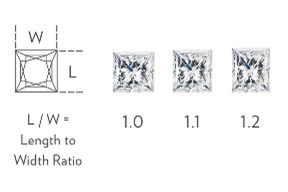
If you prefer a square diamond shape, look for length-to-width ratios between 1 and 1.05. If you prefer more of a rectangular shape, look for length-to-width ratios greater than 1.10. For a princess-cut diamond with superior sparkle, consider an Astor by Blue Nile™ Diamond.
Emerald-Cut Diamond
What makes the emerald shape distinct is its pavilion, which is cut with rectangular facets to create a unique optical appearance. Due to its large open table and step-cut pavilion, this shape highlights the clarity of a diamond. If you choose an emerald-cut diamond with a lower clarity grade, such as SI, be sure to review the clarity plot on the diamond certificate to judge the visibility of the inclusions. This shape can vary greatly in how rectangular the diamond is cut. If you prefer a squared outline, explore Asscher-cut diamonds.
Recommended Length x Width Ratio
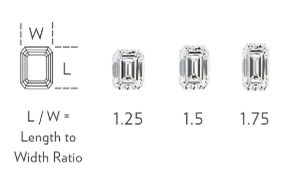
Asscher-Cut Diamond
This beautifully distinct shape is nearly identical to the emerald-cut diamond, except that it's square. An Asscher’s pavilion is cut with rectangular facets in the same style as the emerald. If you're choosing a lower clarity grade, be sure to view the clarity plot on the diamond certificate to judge the visibility of the inclusions. Also, this shape tends to show slight color in the corners, so you may want to spend a little more for a higher color grade.
Recommended Length x Width Ratio
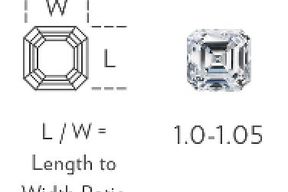
Marquise-Cut Diamond
The shape of a marquise can maximize carat weight, giving you a much larger-looking diamond. This brilliant-cut diamond looks beautiful set with round or pear-shaped side stones, and the length of the marquise diamond is flattering to fingers.
Recommended Length x Width Ratio
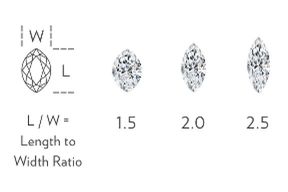
Oval-Cut Diamond
An oval-shaped diamond has beautiful brilliance that's similar to a round diamond. Oval diamonds are also very popular as their length can accentuate long, slender fingers.
Recommended Length x Width Ratio
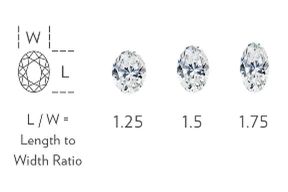
Radiant-Cut Diamond
Trimmed corners are the signature of this diamond, and they help make the radiant shape a popular and versatile choice for jewelry. This shape looks equally beautiful set with either baguette or round side-diamonds. Radiant-cut diamonds can vary in their degree of rectangularity.
Recommended Length x Width Ratio
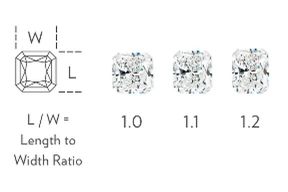
Pear-Shaped Diamond
This brilliant-cut diamond is also called a teardrop for its single point and rounded end. The unique look of the pear shape helps make it a popular choice for a variety of diamond jewelry. If you choose an elongated pear shape, the length of the diamond creates a subtle slimming effect on the fingers.
Recommended Length x Width Ratio
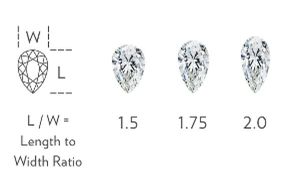
Heart-Shaped Diamond
The heart is the ultimate symbol of love. The unique look of the heart-shaped diamond helps make it a distinctive choice for a variety of diamond jewelry. This shape tends to show slight color in its point, so you may want to budget for a higher color grade than you'd need when buying a round diamond.
Recommended Length x Width Ratio
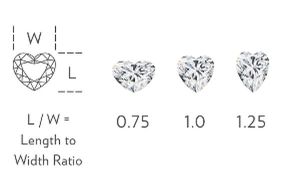
Cushion-Cut Diamond
This unique shape has been popular for more than a century. Cushion-cut diamonds (also known as pillow-cut diamonds) have rounded corners and larger facets to increase their brilliance. These larger facets can show inclusions more easily than some other shapes, so if you choose a lower clarity grade, be sure to review the clarity plot on the diamond certificate. Cushion-shaped diamonds are available in shapes ranging from square to rectangular.
Recommended Length x Width Ratio
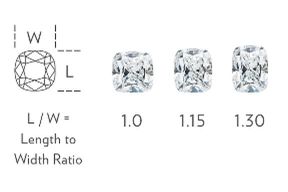
What Is The Bow-Tie Effect And Which Diamond Shapes Does It Affect?
The depth and positioning of facets in the center of some fancy-shaped diamonds can cause a shadow or dark area to appear horizontally through the center of the stone. This most often resembles a ‘bow tie’ in oval, marquise, pear and sometimes heart shapes. While it is possible for cutters to eliminate and lessen the intensity of a bow-tie, it isn’t as simple as it sounds. The skill and experience of the diamond cutter plays a significant role when working with pears, ovals, marquise and hearts. Meanwhile, they are trying to balance the realities of economics to cut the largest, nicest diamond they can from the rough crystal. When looking at these shapes, you can use our rotating 360° photo to ensure that you like the pattern that appears. Or, call our experts to help you review it.
Have A Question?
Contact us by phone at 1-800-242-2728 or email at service@bluenile.com.
In addition, Live Chat is available during most business hours.